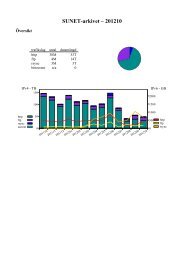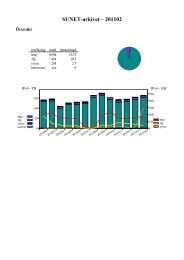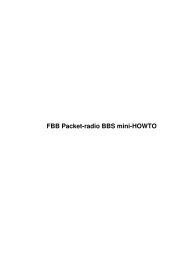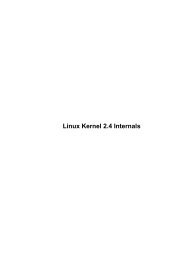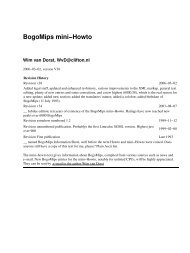Linux IP Masquerade HOWTO - The Linux Documentation Project
Linux IP Masquerade HOWTO - The Linux Documentation Project
Linux IP Masquerade HOWTO - The Linux Documentation Project
Create successful ePaper yourself
Turn your PDF publications into a flip-book with our unique Google optimized e-Paper software.
# v0.61<br />
#<br />
# NOTE: <strong>The</strong> following is an example to allow only <strong>IP</strong> Masquerading for the<br />
# 192.168.0.2 and 192.168.0.8 machines with a 255.255.255.0 or a<br />
# "/24" subnet mask connecting to the Internet on interface eth0.<br />
#<br />
# ** Please change the network number, subnet mask, and the Internet<br />
# ** connection interface name to match your internal LAN setup<br />
#<br />
echo " − Setting the default FORWARD policy to DROP"<br />
$<strong>IP</strong>TABLES −P FORWARD DROP<br />
echo " − Enabling SNAT (<strong>IP</strong>MASQ) functionality on $EXTIF"<br />
$<strong>IP</strong>TABLES −t nat −A POSTROUTING −o $EXTIF −s 192.168.0.2/32 −j MASQUERADE<br />
$<strong>IP</strong>TABLES −t nat −A POSTROUTING −o $EXTIF −s 192.168.0.8/32 −j MASQUERADE<br />
echo " − Setting the FORWARD policy to 'DROP' all incoming / unrelated traffic"<br />
$<strong>IP</strong>TABLES −A INPUT −i $EXTIF −m state −−state NEW,INVALID −j DROP<br />
$<strong>IP</strong>TABLES −A FORWARD −i $EXTIF −m state −−state NEW,INVALID −j DROP<br />
Common mistakes:<br />
It appears that a common mistake with new <strong>IP</strong> Masq users is to make the first command simply the following:<br />
<strong>IP</strong>TABLES:<br />
−−−−−−−−−<br />
iptables −t nat −A POSTROUTING −j MASQUERADE<br />
Do NOT make your default policy MASQUERADING. Otherwise, someone can manipulate their routing<br />
tables to tunnel straight back through your gateway, using it to masquerade their OWN identity!<br />
Again, you can add these lines to the /etc/rc.d/rc.firewall−iptables file, one of the other rc<br />
files you prefer, or do it manually every time you need <strong>IP</strong> <strong>Masquerade</strong>.<br />
Please see Section 6.4.1 for a detailed guide on a strong <strong>IP</strong>TABLES ruleset example. For additional details on<br />
<strong>IP</strong>TABLES usage, please refer to http://www.netfilter.org/ for the primary <strong>IP</strong>TABLES site.<br />
3.4.2. Configuring <strong>IP</strong> <strong>Masquerade</strong> on <strong>Linux</strong> 2.2.x Kernels<br />
Please note that <strong>IP</strong>FWADM is no longer the firewall tool for manipulating <strong>IP</strong> Masquerading rules for both<br />
the 2.1.x and 2.2.x kernels. <strong>The</strong>se new kernels now use the <strong>IP</strong>CHAINS toolkit. For a more detailed reason for<br />
this change, please see Chapter 7.<br />
Create the file /etc/rc.d/rc.firewall−ipchains with the following initial SIMPLE ruleset:<br />
<br />
<strong>Linux</strong> <strong>IP</strong> <strong>Masquerade</strong> <strong>HOWTO</strong><br />
#!/bin/sh<br />
#<br />
# rc.firewall−ipchains<br />
#<br />
# − Initial SIMPLE <strong>IP</strong> <strong>Masquerade</strong> test for 2.1.x and 2.2.x kernels<br />
# using <strong>IP</strong>CHAINS.<br />
#<br />
# Once <strong>IP</strong> Masquerading has been tested, with this simple<br />
# ruleset, it is highly recommended to use a stronger<br />
# <strong>IP</strong>TABLES ruleset either given later in this <strong>HOWTO</strong> or<br />
# from another reputable resource.<br />
Chapter 3. Setting Up <strong>IP</strong> <strong>Masquerade</strong> 45










